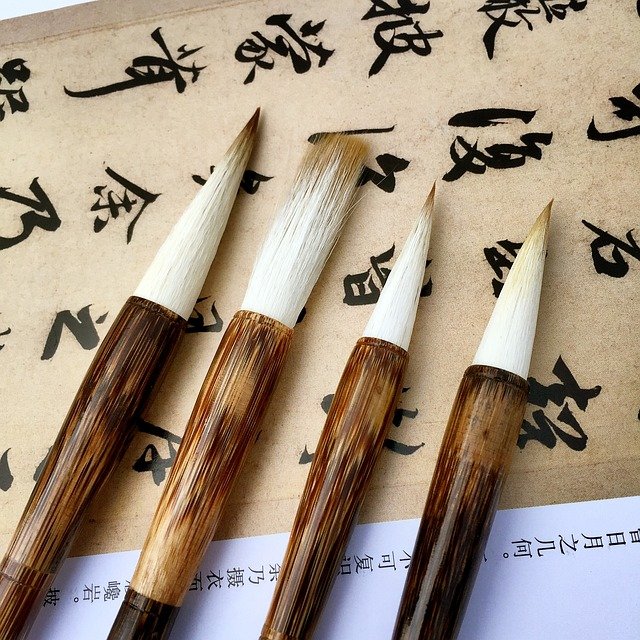Imagine stepping into a quiet room where the atmosphere is filled with the soft sound of brushes gliding over paper, the subtle scent of ink rising in the air. Each stroke of the brush, although seemingly simple, is imbued with centuries of tradition, precision, and artistry. This is the world of Chinese calligraphy, known as 书法 (shūfǎ), where every brushstroke carries meaning and every character represents a piece of the artist’s soul.
At the heart of Chinese calligraphy lies the brush, or 毛笔 (máobǐ). Far more than just a tool, the brush is an extension of the artist’s hand, mind, and spirit. The mastery of brush techniques is fundamental to creating characters that are not only visually appealing but also full of life and energy. In this article, we will explore both fundamental and advanced brush techniques in Chinese calligraphy, offering insights into how these methods shape not only the appearance of the characters but also the emotional depth conveyed in each stroke.
For those eager to delve deeper into this captivating art form, LC Chinese School in Oslo offers comprehensive Chinese calligraphy classes for all skill levels. You can register for these courses here.
Table of Contents
ToggleThe Essence of Brush Techniques in Chinese Calligraphy
Chinese calligraphy is often described as the art of the written word. It is not merely a method of writing but a deeply spiritual practice that allows the calligrapher to express their inner thoughts and feelings. The brush is the main tool in this form of artistic expression, and the way it is used can transform simple characters into works of art.
In Chinese culture, there is a saying: “字如其人 (zì rú qí rén)”, meaning “the character is like the person.” This reflects the belief that the way a person writes mirrors their personality and emotions. Each stroke, pause, and flick of the brush is intentional, conveying not only the meaning of the word but also the energy and spirit of the writer.
Brush techniques are essential because they provide the structure and rhythm needed to bring a character to life. Without mastery of these techniques, the characters can appear stiff and lifeless. A skilled calligrapher, on the other hand, can make each stroke dance on the paper, creating a visual and emotional experience for the viewer.
Fundamental Brush Techniques: The Foundation of Calligraphy
Holding the Brush (执笔 – zhíbǐ)
The first step in mastering Chinese calligraphy is learning how to properly hold the brush. This may seem simple, but it requires careful attention to ensure that the brush is both firm and flexible in your hand. The brush is typically held vertically, allowing for full control over the movement and pressure.
The most common way to hold the brush is with the five-finger grip (五指执笔法 – wǔ zhǐ zhíbǐ fǎ), where the thumb and index finger grip the brush while the other fingers support and balance it. This grip provides stability while allowing the brush to move freely in all directions.
Maintaining the correct posture and grip is crucial. The hand should be relaxed, but steady. If the grip is too tight, the strokes will appear rigid; if too loose, the strokes will lack control.
Basic Strokes (笔画 – bǐhuà)
Chinese characters are made up of various strokes, each requiring a specific technique. Mastery of these basic strokes is the foundation of calligraphy, and each stroke should be practiced repeatedly until it becomes second nature.
Some of the essential strokes in Chinese calligraphy include:
1. Horizontal Stroke (横 – héng)
The horizontal stroke is one of the most fundamental in calligraphy. It begins with a light press at the start of the stroke to anchor the brush. As you move to the right, the pressure remains steady, and the stroke finishes with a gentle lift. The result should be a smooth, even line, symbolizing stability and balance.
2. Vertical Stroke (竖 – shù)
The vertical stroke moves from top to bottom, representing strength and uprightness. Begin by pressing the brush slightly at the top, then pull the brush downward in a controlled, smooth motion. The stroke should end with a subtle lift, giving it a clean, finished appearance.
3. Dot (点 – diǎn)
Though small, the dot is a vital element in Chinese calligraphy. It is made with a quick, controlled touch of the brush to the paper, applying pressure briefly before lifting it. The dot may be small, but it carries significant energy and should never be overlooked as a simple stroke.
4. Left-Falling Stroke (撇 – piě)
The left-falling stroke starts lightly and gains pressure as it moves diagonally downward to the left. It finishes with a sharp upward flick. This stroke adds a sense of flow and movement to the character, as if the brush were mimicking the natural motion of a falling leaf.
5. Right-Falling Stroke (捺 – nà)
The right-falling stroke is similar to the left-falling stroke but moves diagonally downward to the right. It begins lightly, gradually increasing pressure, and concludes with a controlled lift. This stroke adds momentum and dynamism to the character.
6. Hook (钩 – gōu)
The hook stroke gives characters complexity and character. It is created after a vertical or horizontal stroke and requires a sharp turn to form the hook. The hook stroke must be executed with precision and confidence to add depth to the character.
Stroke Order (笔顺 – bǐshùn)
The correct stroke order is crucial in Chinese calligraphy, as it affects the flow and balance of the character. Following the traditional stroke order ensures that the character is written harmoniously and with ease.
The general rules for stroke order are:
- Top to Bottom (从上到下 – cóng shàng dào xià): Begin writing from the top of the character downwards.
- Left to Right (从左到右 – cóng zuǒ dào yòu): Complete strokes on the left side of the character before moving to the right.
- Horizontal before Vertical (先横后竖 – xiān héng hòu shù): Horizontal strokes should be written before vertical strokes.
- Inside before Closing (先内后封 – xiān nèi hòu fēng): For characters with enclosing strokes, the inner strokes are written first.
By following these stroke order rules, the character will maintain a natural balance and rhythm.
Advanced Brush Techniques: Bringing Characters to Life
Once you have mastered the basic strokes, you can begin to explore more advanced brush techniques that add layers of depth, expression, and personality to your calligraphy. These techniques involve manipulating pressure, speed, rhythm, and even the amount of ink used in each stroke.
Controlling Pressure (提按 – tí àn)
In Chinese calligraphy, the amount of pressure applied to the brush greatly influences the thickness and texture of each stroke. Calligraphers use varying levels of pressure to create contrast and depth within a single character.
- Heavy Pressure produces thick, bold lines, giving a sense of strength and stability.
- Light Pressure results in thin, delicate lines that add grace and subtlety to the character.
By mastering pressure control, you can create strokes that start thick and gradually thin out, or vice versa. This technique adds a dynamic quality to the character, making it feel alive on the page.
Speed and Rhythm (速度与节奏 – sùdù yǔ jiézòu)
The speed at which a stroke is executed also impacts the character’s emotional tone. Quick, fluid strokes convey energy and vitality, while slower, more deliberate strokes suggest calm and control.
In cursive script (草书 – cǎoshū), the strokes are often written quickly and continuously, creating a sense of freedom and spontaneity. In contrast, the regular script (楷书 – kǎishū) requires more careful, slower strokes, emphasizing clarity and precision.
Maintaining a consistent rhythm throughout a piece is key to creating harmonious calligraphy. The strokes should not appear disjointed but should flow together as part of a continuous, rhythmic movement.
Wet and Dry Brush Techniques (干湿笔法 – gān shī bǐ fǎ)
Manipulating the amount of ink on the brush can dramatically affect the appearance of the strokes.
- Dry Brush Techniques use less ink, creating rough, textured strokes that give the character a sense of age or expressiveness.
- Wet Brush Techniques involve a brush saturated with ink, producing bold, smooth strokes that are uniform and solid.
By alternating between wet and dry brush techniques, you can add contrast and texture to your calligraphy, giving the characters a more dynamic and three-dimensional appearance.
The Mind-Brush Connection
In Chinese calligraphy, there is a profound connection between the calligrapher’s mind and their brush. Calligraphy is not just about physical technique; it is a deeply meditative practice that requires full mental engagement. The calligrapher must be present in the moment, focusing entirely on the movement of the brush and the flow of the ink.
A calm and focused mind leads to balanced, harmonious strokes, while a distracted or stressed mind can result in shaky, uneven lines. Many calligraphers describe the process of writing as a form of meditation, where the mind and body work together in perfect harmony.
Learning Chinese Calligraphy at LC Chinese School in Oslo
Mastering Chinese calligraphy is a journey that requires patience, practice, and dedication. At LC Chinese School in Oslo, we offer structured calligraphy classes for beginners and advanced learners alike. Whether you are just starting or looking to refine your skills, our experienced instructors will guide you through the techniques and philosophy behind this ancient art form.
Why Choose LC Chinese School?
- Expert Instructors: Our teachers are seasoned calligraphers with years of experience in teaching traditional Chinese calligraphy.
- Comprehensive Curriculum: Our classes cover everything from basic brush techniques to advanced concepts, ensuring a well-rounded learning experience.
- Cultural Insight: Beyond technique, we delve into the rich cultural and philosophical aspects of Chinese calligraphy, helping you understand the deeper meaning behind each stroke.
If you’re ready to begin your calligraphy journey, register for our classes here.
Flexible Learning Options
We understand that everyone’s schedule is different, which is why we offer a variety of class times to accommodate your needs. Whether you prefer evening, weekend, or weekday classes, we have options that fit your schedule.
Conclusion
Chinese calligraphy is a beautiful and profound art form that goes far beyond simply writing characters. It is a way to express the deepest emotions, thoughts, and spirit of the artist through the movement of a brush. By mastering brush techniques, from the fundamental strokes to the most advanced methods of pressure control, speed, and rhythm, you can transform each character into a living work of art.
At LC Chinese School in Oslo, we are passionate about sharing the art of Chinese calligraphy with our students. Whether you are looking to start from scratch or refine your existing skills, our calligraphy classes offer a perfect blend of technical instruction and cultural immersion. Register now here and begin your journey into the timeless art of 书法 (shūfǎ).
Contact Information:
- Email: info@lcchineseschool.com
- Phone: +47 908 14 756
- Address: Tordneskiolds gate 2, 0160 Oslo, Norway
Join us and become part of a vibrant community dedicated to learning and preserving the art of Chinese calligraphy.







